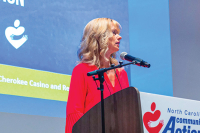Study credits park for tourist spending
According to a recently-released National Park Service study, Great Smoky Mountains National Park is not only the nation’s most visited national park, it also tops the 388 national park units in visitor spending.
The study estimates that in 2005 the Park’s 9.2 million visitors spent more than $652 million in the gateway communities surrounding the Park. The study also estimates that more than 14,000 local jobs were supported by Park visitor spending. The study was sanctioned by the National Park Service as an attempt to track the economic benefits of National Parks.
“The estimates in this study represent dollars that enter a gateway economy as a direct result of a park’s presence and operation. They are an important indicator of the return on the public’s investment of tax dollars in the National Park System,” said Dr. James Gramann of Texas A&M University, who conducted the study as the visiting chief social scientist for the park service.
The study was based on several assumptions regarding park tourists, however. First of all, it assumed that the national park was responsible for bringing all its tourists here, rather than tourists visiting the region due to other drawing cards and merely driving through the park once here.
“Here in Swain County people come to do whitewater rafting and all kinds of outdoor adventure. They also come to the Great Smoky Mountains railroad,” said Gwen Bushyhead, director of the Swain County chamber of Commerce. “What they have in common is that almost everyone wants to visit the waterfalls at Deep Creek
Once they visit Deep Creek, they are counted as a national park visitor and under the study, the park took credit for their spending.
Related Items
“I think people do come to the region because our our resources,” Bushyhead said. But that also includes Lake Fontana.
“We have a lake not like other lakes. An experience they aren’t going to find at lakes where there are houses crowding the shore,” Bushyhead said.
In addition, the study assumed that park tourists were responsible for an equal share of tourist spending in the nearby communities. A visitor to Harrahs Cherokee Casino might spend far more than a sightseer driving through the park, but the study utilized general tourist spending and applied it to park visitors.
“The spending estimates at each park were derived from a money generation model that begins with a park’s visitation, party size, length of stay, and proportion of local vs. non-local visitors. Those statistics are combined with locally-indexed cost estimates for restaurants, lodging, amusements, locally-purchased fuel and transportation, and retail spending,” according to a press release on the study.
At the Great Smoky Mountains National Park the spending estimates were broken down as follows:
• 14 percent of Park visitors were local day-trip visitors assumed to spend an average of $28 per party.
• 22 percent were non-local people visiting for a day and spending $93 per group.
• 53 percent were overnight guests staying outside the Park in hotels and spending $243 per party per night.
• 11 percent were parties who camped either in or outside the Park and spent, on average, $130 per night for the group.
“When community leaders in Tennessee and North Carolina sought to create this national park early in the last century, many were concerned primarily about preserving a vanishing portion of the scenic and biologically significant Appalachian Mountains,” said Smokies Superintendent Dale Ditmanson said. “Those preservation-minded individuals were teamed up with those who saw the creation of a national park as an economic magnet. Fortunately, both interests got what they wanted.”
Ditmanson said the absence of hotels, restaurants and other visitor services in the park allowed local communities to caputre those tourist dollars.
According to the study, the top five park service locations units in terms of spending generated were Great Smokies with $652 million, Grand Canyon at $416 million, Yosemite with $317 million, Yellowstone at $298 million and the Blue Ridge Parkway with $294 million.









